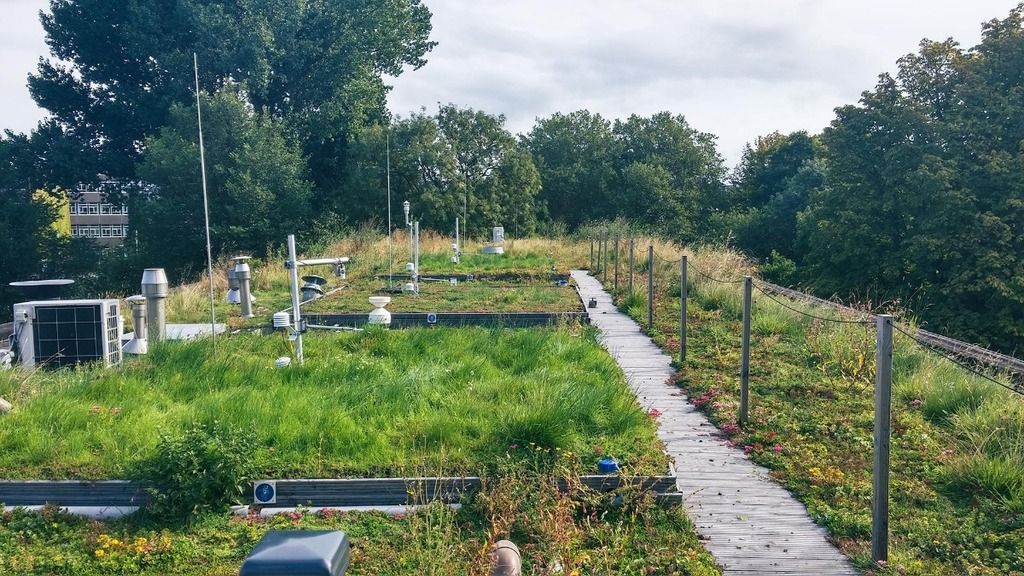How we turned our office into a living lab with a green roof
Green roofs are becoming more and more popular around the world. These living roofs transform buildings into ecological systems that benefits its surrounding environment.
Posted by
Published on
Tue 29 Jun. 2021
Topics
| Environmental Enrichment | Insects | Living Labs | Ecosystem | Sustainability | Biodiversity |

Green roofs are becoming more and more popular around the world. These living roofs transform buildings into ecological systems that benefits its surrounding environment. A green roof, or living roof as it’s also called, is a roof of a building that is (partially) covered with vegetation that is planted over a waterproofing membrane¹. It goes beyond the average container gardens where plants are usually maintained in pots. While the installation of a green roof initially takes investing time and money, there are plenty of advantages.
The advantages of a green roof
- A green roof provides extra insulation, so cooling in the summer, heating in the winter, and saving on energy costs at the same time.
- A green roof contributes to the retention of rainwater, thus reducing the burden on the sewer system, which is an important theme in urban environments these days.
- A green roof extends the life of the bitumen roofing.
- And last but not least: a green ‘living’ roof provides for a beautiful natural view when looking outside.

Figure 1 Cross section of possible green roofs (by Eva Drukker)
Figure 1 shows a cross section of three possible green roofs. Depending on how much the roof can carry, the substrate (soil) depth can vary. On the Noldus building the roof load was calculated to be able to carry the Herbaceous roof type represented in the middle.
Noldus and sustainability
We believe that companies of any size can make a difference in sustainability. That is why we organize our business processes in an ecologically sustainable manner. We minimize waste, choose our materials responsibly, and are mindful about travelling. Our office buildings are also included in our efforts for sustainable business.
Our building in Wageningen is partially equipped with a sedum roof (figure 1a). It covers the building’s social area and canteen. On the top roof, solar panels and heat pumps are installed to regulate the temperature inside the building. Also, the surrounding grounds are planted with native trees and shrubs, and managed without use of chemicals.

The sedum roof that covers our building's canteen
How we turned our office into a living lab with a green roof
Recently we decided to take it a step further and convert two pebble-covered roofs of our Wageningen office into ‘green roofs’, with a biodiverse vegetation cover (figure 1b). The bearing capacity of these concrete roofs is high, making a thicker substrate possible, which offers many more options for vegetation, and subsequently research.
A living lab
The design of the vegetation layer is a co-production of Koninklijke Ginkel Groep (a Dutch company specialized in sustainable landscaping and roof gardens) and Eva Drukker, researcher at Wageningen University and Research (WUR), the Netherlands. Eva will use the roofs for her PhD research to look into the effect of green roofs on biodiversity, in particular the diversity of insects. She will study the effect of two variables on vegetation development and colonization by insects.
The design has divided the two roofs into four different zones, based on orientation towards the sun (north, south) and mineral content of the substrate (low or high in calcium). A seed mixture of locally and regionally occurring grasses and herbs are sown. By sowing seeds, we are also giving nature a chance to colonize the green roof by itself and make this roof more natural. Usually “sedum mats” are rolled out over the roof, so that it will immediately look “nice and pretty”. However these mats do not contribute much to biodiversity as many bees and butterflies do not use these sedum plants for their life cycle events and pollination.

Examples of a green roof used for research (photo & video by Eva Drukker)
Research the effect of green roofs on biodiversity
In the research, Eva is investigating how the surrounding landscape influences the colonization of plants and insects on green roofs. Several questions are adressed regarding the Noldus roof:
- How does the initial vegetation and soil composition affect the colonization of spontaneous plants species, soil communities and larger insects?
- Which species are able to survive on these green roofs over time?
The research conducted here is quite unique, as we will be able to perform t0 measurements (starting right after construction of the roof) and measuring everything from the roof; soil quality, vegetation structure, as well as micro-, macro- and megafauna.
We will do moth catching, bat and bird monitoring and assess how a green roof might enhance their populations.
Urban Green Infrastructure
With the information gathered over the years we will have a better understanding of these small ecosystems and how to effectively integrate them in the Urban Green Infrastructure, where they can play an important role for flora and fauna as stepping stones and green corridors in our heavily packed cities.
This research is being conducted also in Amsterdam and can be followed on her Instagram account: GreenroofBiodiverCity. We’re very much looking forward to the study and results in the upcoming years. Read more about our mission and values here.
This blog post was co-written by Eva Drukker
References
Related Posts

Insect damage on leaves changes the reproductive strategy of plants

Assessing motor deficits in mice following traumatic brain injury
